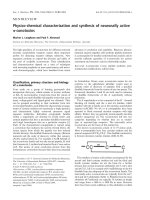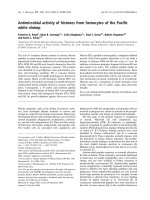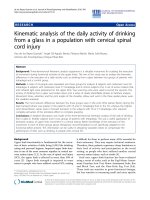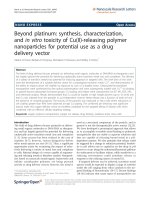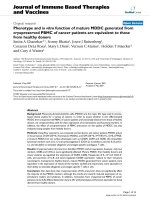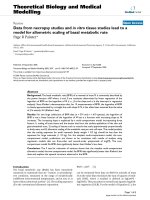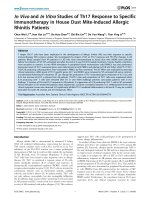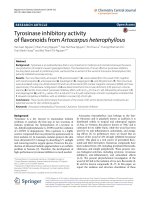Chemical characterization and prebiotic activity of fructo-oligosaccharides from Stevia rebaudiana (Bertoni) roots and in vitro adventitious root cultures
Bạn đang xem bản rút gọn của tài liệu. Xem và tải ngay bản đầy đủ của tài liệu tại đây (1.45 MB, 8 trang )
Carbohydrate Polymers 152 (2016) 718–725
Contents lists available at ScienceDirect
Carbohydrate Polymers
journal homepage: www.elsevier.com/locate/carbpol
Chemical characterization and prebiotic activity of
fructo-oligosaccharides from Stevia rebaudiana (Bertoni) roots and
in vitro adventitious root cultures
Sheila Mara Sanches Lopes a , Mariane Grigio Francisco b , Bruna Higashi a ,
Rafaela Takako Ribeiro de Almeida c , Gabriela Krausová d , Eduardo Jorge Pilau c ,
José Eduardo Gonc¸alves e , Regina Aparecida Correia Gonc¸alves a,b ,
Arildo José Braz de Oliveira a,b,∗
a
Graduate Program in Pharmaceutical Sciences, State University of Maringá, Ave. Colombo 5790, 87.020-900, Maringá, Brazil
Department of Pharmacy, State University of Maringá, Ave. Colombo 5790, 87.020-900, Maringá, Brazil
Department of Chemistry, State University of Maringá, Ave. Colombo 5790, 87.020-900, Maringá, Brazil
d
Department of Microbiology and Technology, Dairy Research Institute, Ke Dvoru 12a, 160 00 Prague, Czech Republic
e
Program of Master in Health Promotion, University Center of Maringá, Ave. Guedner, 1610, 87.050-900, Maringá, Brazil
b
c
a r t i c l e
i n f o
Article history:
Received 28 April 2016
Received in revised form 5 July 2016
Accepted 12 July 2016
Available online 14 July 2016
Chemical compounds studied in this article:
Inulin from chicory (PubChem CID:
16219508)
Fructose (PubChem CID: 5984)
Glucose (PubChem CID: 5793)
Sucrose (PubChem CID: 5988)
Agar (PubChem CID: 76645041)
␣-Naphthaleneacetic Acid (PubChem CID:
6862)
Trifluoroacetic Acid (PubChem CID: 6422)
Ethanol (PubChem CID: 702)
Tween 80 (PubChem CID: 86289060)
l-Cysteine Hydrochloride (PubChem CID:
60960)
a b s t r a c t
Stevia rebaudiana (Bertoni) is widely studied because of its foliar steviol glycosides. Fructan-type
polysaccharides were recently isolated from its roots. Fructans are reserve carbohydrates that have
important positive health effects and technological applications in the food industry. The objective of
the present study was to isolate and characterize fructo-oligosaccharides (FOSs) from S. rebaudiana roots
and in vitro adventitious root cultures and evaluate the potential prebiotic effect of these molecules.
The in vitro adventitious root cultures were obtained using a roller bottle system. Chemical analyses (gas chromatography-mass spectrometry, 1 H nuclear magnetic resonance, and off-line electrospray
ionization-mass spectrometry) revealed similar chemical properties of FOSs that were obtained from
the different sources. The potential prebiotic effects of FOSs that were isolated from S. rebaudiana roots
enhanced the growth of both bifidobacteria and lactobacilli, with strains specificity in their fermentation
ability.
© 2016 Elsevier Ltd. All rights reserved.
Keywords:
Fructo-oligosaccharides
Stevia rebaudiana
Adventitious root cultures
Prebiotic potential
Abbreviation: FOSs, fructo-oligosaccharides; DP, degree of polymerization; DPn , average degree of polymerization; MS, Murashige Skoog medium; GI, growth index;
1-SST, sucrose: sucrose 1-fructosyltransferase; 1-FFT, fructan: fructan 1-fructosyltransferases.
∗ Corresponding author at: State University of Maringá Ave. Colombo 5790, 87.020−900, Maringá Brazil.
E-mail addresses: sanches (S.M. Sanches Lopes), mariane (M.G. Francisco), (B. Higashi),
(R.T.R. de Almeida), (G. Krausová), (E.J. Pilau), (J.E. Goncáalves),
(R.A.C. Goncáalves), , (A.J.B.d. Oliveira).
/>0144-8617/â 2016 Elsevier Ltd. All rights reserved.
S.M. Sanches Lopes et al. / Carbohydrate Polymers 152 (2016) 718–725
1. Introduction
Stevia rebaudiana (Bertoni) is a perennial herb that belongs to the
Asteraceae family. It is native to South America and widely known
for its foliar diterpenoid steviol glycoside content, with a sweet
flavor and low calories (Lemus-Mondaca, Vega-Gálvez, Zura-Bravo,
& Ah-Hen, 2012; Moraes, Donega, Cantrell, Mello, & McChesney,
2013). Previous studies have reported the presence of fructan-type
polysaccharides that have commercial applications, such as inulin
with a high degree of polymerization (DP) (Lopes et al., 2015) and
fructan fractions (DP = 17) from their roots (Oliveira et al., 2011).
Fructans are a group of non-digestible carbohydrates that have
a linear structure comprising (2 → 1)-linked -d-fructofuranosyl
units, mostly ending with a glucose residue (Fig. 1) (Verspreet,
Dornez, Van den Ende, Delcour, & Courtin, 2015). These native
molecules are a mixture of oligomer and polymer chains with a variable number of fructose molecules. Fructo-oligosaccharides (FOSs)
are short-chain fructans (DP = 3–8). Fructan molecules with DP > 10
are denominated as inulin (Karimi, Azizi, Ghasemlouc, & Vaziri,
2015; Meyer, Bayarri, Tárrega, & Costell, 2011; Villegas, Tárrega,
Carbonell, & Costell, 2010).
Inulin and FOSs have applications as functional food and prebiotic nutrients (Caleffi et al., 2015; Morris & Morris, 2012; Verspreet,
Dornez et al., 2015). The -configuration of anomeric carbon C2
in these molecules makes it a non-digestible carbohydrate in the
upper portion of the human intestinal tract, but they can be fermented in the colon for a limited number of beneficial colonic
bacteria that selectively influence the growth and/or activity of
microbiota (Morris & Morris, 2012; Roberfroid et al., 2010).
The fermentation process that is associated with these
molecules results in various beneficial effects, such as improvements in the intestinal absorption of minerals, increases in the
cellularity and number of crypts that result from the production
of short-chain fatty acids (Lobo et al., 2011; Pitarresi, Tripodo,
Cavallaro, Palumbo, & Giammona, 2008), a reduction of triglyceride and cholesterol levels, the modulation of hyperglycemia
(Nishimura et al., 2015), and improvements in the efficiency of the
immune system (Dwivedi, Kumar, Laddha, & Kemp, 2016; MorenoVilet et al., 2014; Peshev & Van den End, 2014).
In addition to their health benefits, fructans have important
technological properties as a replacement for fat and sugar in lowcalorie food and as a texturizing agent that is related to the DP
of these molecules (Aravind, Sissons, Fellows, Blazek, & Gilbert,
2012; Crispín-Isidro, Lobato-Calleros, Espinosa-Andrews, AlvarezRamirez, & Vernon-Carter, 2015). Fructo-oligosaccharides are used
as dietary fiber and a sugar replacement because of their high solubility and characteristic sweetness (Sołowiej et al., 2015; Villegas
et al., 2010).
In vitro plant cell, tissue, or organ cultures are alternative methods for the cultivation of whole plants with active metabolism and
a high rate of biomass production. Adventitious roots can be used as
raw materials in industry as an option that replace the extrativism
of medicinal plants (Baque, Moh, Lee, Zhong, & Paek, 2012; Silja
& Satheeshkumar, 2015; Thiyagarajan & Venkatachalam, 2012).
These biotechnological methods are sustainable production techniques used for obtaining bioactive compounds with interest in
pharmaceutical, food, and cosmetic industry (Baque et al., 2012;
Cui et al., 2011; Lee & Paek, 2012; Lulu, Park, Ibrahim, & Paek, 2014).
The isolation of FOSs with a low DP from S. rebaudiana roots has
not been performed previously. Only inulin molecules with a high
DP from S. rebaudiana roots have been characterized (Lopes et al.,
2015; Oliveira et al., 2011). Considering the commercial interest
of FOS molecules and importance of biotechnological methods as
sustainable production techniques for bioactive compounds, the
objective of the present study was to isolate and characterize FOSs
from S. rebaudiana roots and in vitro adventitious roots that were
719
cultured in a roller bottle system. We also evaluated the potential
prebiotic effects of these molecules in vitro.
2. Materials and methods
2.1. Plant and chemical materials
Stevia rebaudiana (Bertoni) specimens were identified by Jimi
Naoki Nakagima (Federal University of Uberlândia) in March 2008.
A voucher specimen (14301-HUEM) was deposited at the Herbarium of the State University of Maringá, Brazil. The S. rebaudiana
seeds and cultivar roots were obtained at the Iguatemi Research
Station of the State University of Maringá.
We used fructo-oligosaccharide (Orafti® P95, Beneo-Orafti,
Belgium) with a DP < 10, product of the partial enzymatic hydrolysis of chicory inulin. Fructose, glucose, and a myo-inositol standard
were purchased from Sigma-Aldrich. All of the other reagents and
nutrients for the culture medium were of analytical grade.
2.2. Culture of S. rebaudiana adventitious roots in a roller bottle
system
Aseptic cultures of S. rebaudiana adventitious roots were
obtained by organogenesis from shoots originated by in vitro seed
germination in Murashige and Skoog (1962) nutrient medium
that was supplemented with 30 g/L d-sucrose, 1% agar (w/v), and
2.0 mg/L ␣-naphthaleneacetic acid (NAA; i.e., a phytoregulator that
induces adventitious root formation). The cultures were maintained at 28 ± 1 ◦ C with a 16 h photoperiod at a photon flux density
of 20–50 mmol m−2 s−1 from daylight fluorescent lights (Reis et al.,
2011).
Approximately 0.05 g of fresh roots that were obtained from in
vitro shoots was transferred to Schott-type flasks (15 cm length,
6 cm diameter, and 250 ml volume) that contained 15 ml of liquid
medium with 33.3% strength Murashige and Skoog (MS/3) medium
that was supplemented with 30 g/L d-sucrose and 2.0 mg/L ␣-NAA.
The S. rebaudiana adventitious roots were cultivated in a roller bottle system at 2 rotations per minute at 25 ± 1 ◦ C under dark and
light conditions.
The growth curve of S. rebaudiana adventitious roots was
determined over 5 weeks. Two independent experiments were performed to evaluate the reproducibility of the root growth profile.
The growth index (GI) of the adventitious roots was calculated
as the following, based on the fresh weight of final roots (FWf )
and fresh weight of inoculated roots (FWi ) (Silja & Satheeshkumar,
2015):
Growth
Index(GI) =
FWf − FWi
FWi
2.3. Total sugar determination
The total carbohydrate content in the extracts was determined
by the phenol-sulfuric acid method with d-fructose as the standard
(Dubois, Gilles, Hamilton, Reberes, & Smith, 1956).
2.4. Fructo-oligosaccharide extraction
The S. rebaudiana roots were dried in a drying oven at 48 ◦ C for
3 days, milled, and extracted with water under reflux conditions
at 80 ◦ C for 5 h. The aqueous extract was filtered and concentrated
in a rotary evaporator. The crude aqueous extract was precipitated
with ethanol PA (1:3; v/v). The material was refrigerated overnight
at 4 ◦ C and then centrifuged at 6000 × g for 20 min. The ethanolic
supernatant was collected, stored in freezer and lyophilized (Fig.
S1), yielding the dry extract of the soluble fructan fraction (SFF).
720
S.M. Sanches Lopes et al. / Carbohydrate Polymers 152 (2016) 718–725
Fig. 1. Simplified scheme of the fructan biosynthesis: Sucrose (1), 1-Kestose (2) and general fructans formula (3) (n represent the number of fructose units). Enzymes of the
process: 1-SST – sucrose:sucrose 1-fructosyltransferase, 1-FFT – fructan:fructan 1-fructosyltransferase.
The S. rebaudiana adventitious roots were lyophilized and milled
separately each week and extracted with distilled water under
reflux conditions at 80 ◦ C for 5 h. The aqueous extract was filtered and concentrated in a rotary evaporator up to a final volume
of 20 ml. The extract was then lyophilized, resulting in the total
fructan extract (TFE). The TFE from 28-day-old roots was used to
characterize the fructan content of S. rebaudiana adventitious roots.
2.5. Monosaccharide composition
The sugar composition was determined by gas chromatographymass spectrometry (GC–MS) using an Agilent 7890 B gas chromatograph coupled to an Agilent 5977A MSD mass spectrometer. The
samples were hydrolyzed with 0.5 M trifluoroacetic acid at 60 ◦ C
for 1 h, followed by an oxime-trimethylsilyl derivatization reaction
(Lopes et al., 2015). myo-Inositol was added to the samples as the
internal standard.
The oxime-silylated derivatives (dissolved in 200 l of hexane)
were analyzed by GC–MS using an HP5-MS UI-Agilent with a fused
silica capillary column (30 m × 0.25 mm × 0.25 m). Helium was
used as the carrier gas, with an oven temperature of 170–210 ◦ C
(2 ◦ C/min). The injector and interface were kept at 280 ◦ C and
260 ◦ C, respectively. The injections were made in split mode with a
split ratio of 1:40. The mass spectrometer was operated in electron
impact (EI) mode at 70 eV. The quadrupole and source temperatures
were 150 ◦ C and 230 ◦ C, respectively.
The compounds were identified using the NIST Mass Spectral
Library Database (NIST 11) and with comparisons of the mass spectra and retention times of glucose and fructose standards that were
analyzed under the same conditions. The monosaccharide concentrations were obtained by analyzing the relative area integration
of the chromatographic peaks that were corrected to the internal
standard (Lopes et al., 2015).
2.6.
1H
nuclear magnetic resonance spectroscopy
The nuclear magnetic resonance (NMR) spectra were recorded
at 298 K using a Bruker Avance III HD spectrometer that was
operated at 500.00 MHz for the 1 H nucleus using the standard
pulse sequences that are available in the Bruker software. The
fructo-oligosaccharide samples were dissolved in 99.95% D2 O
(20 mg/0.7 ml). The chemical shifts (ı) are expressed in parts per
million. The chemical shifts were compared with the FOS sample
(Orafti® P95) and the literature data (Caleffi et al., 2015; Lopes et al.,
2015).
2.7. Electrospray ionization-mass spectrometry
The SFF and TFE were introduced to the Quattro Micro API mass
spectrometer (Waters) using a syringe pump (40 l/min) for offline electrospray ionization-mass spectrometry (ESI–MS) analysis.
The mass spectra were obtained in positive ionization mode, with
a capillary voltage of 3500 V, cone voltage of 70 V, source temperature or 120 ◦ C, and desolvation temperature of 350 ◦ C. Each
spectrum was produced by the accumulation of data over 1 min
(Oliveira et al., 2011).
2.8. Prebiotic effect
2.8.1. Bacterial strains
To test prebiotic effects in vitro, five strains of lactobacilli and
five strains of bifidobacteria were used. Strains with a CCDM identification number were obtained from the Culture Collection of
Dairy Microorganisms (CCDM, Laktoflora, Czech Republic). The JKM
and JOV strains were obtained from the Czech University of Life
Sciences (Prague, Czech Republic) and were isolates from infant
feces. The other strains were obtained from the Dairy Research
Institute (Tabor, Czech Republic). The commercial strain Bif. animalis subsp. lactis Bb12 was purchased from Chr. Hansen (Starovice,
Czech Republic).
2.8.2. Bacterial growth
Basal medium (10 g tryptone, 10 g peptone, 5 g yeast extract,
1 mL of Tween 80, 0.5 g l-cysteine hydrochloride, and 1 L of distilled water) was autoclaved at 121 ◦ C for 15 min. The FOS molecules
that were obtained in the SFF from S. rebaudiana roots were added
at the concentration of 2.0 g/L as the sole carbon source to the
basal medium after sterile filtration (Puradisc FP 30 filter, 0.2 m).
Wilkins Chalgren anaerobic broth (Oxoid, Basingstoke, UK) was
used as a positive control. Basal medium without the addition of
sugar was used as a negative control. For comparisons, medium that
contained Orafti® P95 (2.0 g/L) was used to represent commercially
available chicory FOS-based prebiotic.
S.M. Sanches Lopes et al. / Carbohydrate Polymers 152 (2016) 718–725
721
Fresh bacterial cultures were grown overnight in Wilkins Chalgren broth, centrifuged at 5000 × g for 7 min, and resuspended
in saline. Bacterial suspensions were inoculated into each tested
medium and incubated at 37 ◦ C for 24 h under anaerobic conditions.
All of the strains were grown in triplicate.
Bacterial growth was evaluated as the change in absorbance
of the tested media at a wavelength of 540 nm (A540 ) during
24 h of incubation using a densitometer (DEN-1, Dynex). For the
determination of bacterial metabolites, acetic acid and lactic acid
the isotachophoretic method (IONOSEP 2003, Czech Republic)
was used. The results were evaluated using Microsoft Excel 2007
(Microsoft, Redmond, WA, USA) and Statistica 10 (StatSoft, Prague,
Czech Republic) software. Values of p < 0.05 were considered statistically significant.
3. Results and discussion
3.1. Fructo-oligosaccharide extraction and yield
In the extraction process for S. rebaudiana roots (Fig. S1) the
ethanol precipitation of the aqueous extract was required to separate the fructan molecules of long-chain (precipitate fraction) and
short-chain (supernatant fraction) produced by the plant. This step
was not necessary to aqueous extract of adventitious root cultures
because only fructo-oligosaccharides with short-chain were produced.
The FOS yield from the SFF that was obtained from S. rebaudiana
roots was 24%, and the FOS yield from the TFE that was obtained
from S. rebaudiana adventitious root cultures was 16% under dark
conditions and 9% under light conditions. The two extracts with a
better FOS yield (SFF and TFE in the dark) were similar to species
that are currently used for commercial purposes like Jerusalem artichoke (Helianthus tuberosus) and chicory (Cichorium intybus) (Chi
et al., 2011; Meyer et al., 2011).
3.2. Culture of S. rebaudiana adventitious roots in a roller bottle
system and fructan production
Preliminary experiments with the aqueous extract from S.
rebaudiana adventitious roots that were cultured in a roller bottle system under dark and light conditions showed that cultures
that were grown in the dark had a higher yield and more capacity to accumulate carbohydrate (35.4%) than cultures that were
grown under light conditions (26.6%). Therefore, all of the subsequent experiments that evaluated FOS production were performed
under dark conditions.
The growth curve of S. rebaudiana adventitious roots that were
cultivated in the dark (Fig. 2) showed a lag phase with slow growth
during the first and second weeks. The fresh weight (FW) of these
adventitious roots were 0.073 g and 0.132 g, corresponding to 0.43fold and 1.54-fold increases, respectively. The exponential phase
between the third week (root FW = 0.376 g) and fourth week (root
FW = 0.492 g) reached a maximum growth index (8.5-fold) during
the fourth week of cultivation. Growth deceleration occurred in the
fifth week, with a decline in biomass production (root FW = 0.393 g).
The roller bottle system was chosen for the adventitious root
cultures because it is a well-established methodology in our laboratory (Reis et al., 2011). It has the advantages of slow rotation that
allows temporary immersion of the roots, which improves oxygenation and avoids disrupting young cells that are being formed.
The presence of FOS molecules in the TFE during the growth
period of S. rebaudiana adventitious roots was monitored by off-line
ESI–MS. The data (Fig. S2) showed the presence of FOS molecules
only from the third week (TFE 21-day-old) of culture (i.e., the exponential phase), with the best accumulation profile for the TFE from
Fig. 2. Growth curve and fresh weight of S. rebaudiana adventitious roots, cultivated
in a in a roller bottle system during 5 weeks.
28-day-old roots, which had characteristic peaks of sodium and
potassium adducts in the mass spectrum (Oliveira et al., 2011;
Verspreet, Hansen et al., 2015).
The present data agreed with the literature, in which primary
metabolites are produced in the exponential phase (in vitro root
cultures) or vegetative stage (cultivar roots), periods during which
carbon sources are required for plant growth (Machado et al., 2006;
Ould-Ahmed et al., 2014).
3.3. Chemical characterization of fructo-oligosaccharides
The GC–MS analysis of the FOS samples identified the presence
of the monosaccharides fructose and glucose. The peaks were identified according the retention time in comparison with fructose
(Fig. 3C) and glucose (Fig. 3D) standards, fragmentation profile at
the mass spectra of oxime-silylated derivatives (Fig. S3), besides
the NIST Mass Spectral Library Database.
The SFF chromatogram (Fig. 3A) showed a majority peak that
corresponded to fructose units at retention times of 8.6, 9.5, and
9.8 min. Glucose peaks were identified at retention times of 10.1,
10.6, 12.5. The internal standard myo-inositol was observed at 11.9,
15.1 and 15.7 min. The TPE chromatogram (Fig. 3B) peaks at retention time 7.7, 7.9, 8.0, 9.4 and 9.7 min were assigned as fructose
units and peaks with retention time of 9.8, 10.1, 10.5 and 12.4 min
were identified as glucose.
The quantitative analysis of the SFF by CG-MS showed a higher
content of fructose (11.2%) than glucose (2.2%), whereas the TFE
showed similar fructose (6.5%) and glucose (5.2%) content.
The 1 H NMR spectra (Fig. 4) presented signals of mono-, di, and oligosaccharides. Fructo-oligosaccharide signals of terminal
glucose hydrogen of the fructan (3) chain (H1 -Glc) were assigned
in the anomeric region with chemical shifts at (ı) 5.45 (J = 3.7 Hz).
Signal referents of the residue (→2--Fru) were observed at ı 4.25
(H3-Fru, J = 8.0 Hz) and ı 4.11 (H4-Fru, J = 8.4 Hz) (Fig. 4). All chemical shift values (ı) (Table 1) are similar in the SFF (S. rebaudiana
roots, Fig. 4A), TFE (S. rebaudiana adventitious roots, Fig. 4B) and
FOS commercial (Orafti® P95, Fig. 4C) as well as with the literature
data (Caleffi et al., 2015; Lopes et al., 2015; Oliveira et al., 2011).
Signals of ␣- and -anomeric forms (H1 ) of free glucose
molecules were observed in the SFF and TPE extracts at ı 5.25
and ı 4.66, respectively (Fig. 4) (Cérantola et al., 2004; Zhang et al.,
2013). Signals of sucrose (1) molecules were also observed in the
FOS extracts, their chemical shift values (ı) (Table 1) were assigned
by comparison with sucrose standard (Fig. S4) and literature data
(Matulová, Husárová, Capek, Sancelme & Delort, 2011; Zhang et al.,
2013).
722
S.M. Sanches Lopes et al. / Carbohydrate Polymers 152 (2016) 718–725
Fig. 3. GC–MS Chromatogram (TIC) of oxime-silylated residues of FOS from S. rebaudiana roots: soluble fructan fraction – SFF (A) and S. rebaudiana adventitious roots: total
fructan extract – TFE (B).
Fig. 4.
1
H NMR spectra (500.00 MHz, D2 O at 298 K) of the FOS from S. rebaudiana roots (SFF) (A) and S. rebaudiana adventitious roots (TFE) (B).
S.M. Sanches Lopes et al. / Carbohydrate Polymers 152 (2016) 718–725
723
Table 1
1
H chemical shifts (ı) of fructo-oligosaccharides extracts from S. rebaudiana root
(SFF), adventitious root cultures (TPE) and commercial FOS.
Sample
SFF
TPE
Orafti® P95
Sucrosea
1
Sugar Unit
→2)--Fruf
→2)--Fruf
→2)--Fruf
˛-Glcp-(1→
→2)--Fruf
H Chemical Shifts/ı
1
2
3
4
5
6
3.93−3.71
3.92−3.71
3.92−3.71
5.42
3.68
–
–
–
3.58
–
4.25
4.26
4.25
3.75
4.21
4.11
4.12
4.11
3.48
4.06
3.89
3.89
3.87
3.87
3.87
3.78−3.73
3.79−3.72
3.78−3.76
3.83
3.80
Commercial FOS (Orafti® P95, Beneo-Orafti, Belgium).
®
a
Chemical shifts (ı) of sucrose observed in the SFF, TPE and Orafti P95 samples.
Fig. 6. Fermentability of FOS from S. rebaudiana roots by different bifidobacteria
strains.
sodium adducts [M+Na]+ at m/z 528, 690, 852, 1014, 1176, and
1338, corresponding to FOS molecules of GF2 , GF3 , GF4 , GF5 , GF6 ,
and GF7 , respectively. This technique allowed the observation of the
mixture of oligomer chain with variable number of fructose units.
The FOS molecules in the both extracts showed an average degree
of polymerization (DPn ) = 5.
For the SFF and TFE extracts, we observed the presence of FOS
molecules with DP = 3 (GF2 ), which was denominated 1-kestose (2),
the first trisaccharide in the biosynthesis route of fructans that is
catalyzed by the enzyme sucrose:sucrose 1-fructosyltransferase (1SST; EC 2.4.1.99). The other FOS peaks that are represented by GFn
(Fig. 1) resulted in elongation of the FOS chain by adding n units
of fructose that were catalyzed by the enzyme fructan:fructan 1fructosyltransferase (1-FFT; EC 2.4.1.100) (Ould-Ahmed et al., 2014;
Verspreet, Dornez et al., 2015; Zhao et al., 2011).
The SFF from S. rebaudiana roots and TFE from S. rebaudiana adventitious root cultures showed similar profiles in all of
the chemical experiments, which confirmed the presence of FOS
molecules in both extracts.
Considering recent work with S. rebaudiana roots (Lopes et al.,
2015) and the present results, we propose that two products with
different industrial applications can be obtained using the same
extraction process. Therefore, FOS molecules with a low DP can
be isolated from supernatant ethanolic fractions, and inulin with a
high DP can be isolated from precipitate fractions.
3.4. Prebiotic effects
Fig. 5. Off-line ESI–MS spectra in positive ion mode of FOS from S. rebaudiana roots
(SFF) (A) and S. rebaudiana adventitious roots (TFE) (B).
In the region between ı 3.65 and 3.95 ppm, were identified other
fructosyl hydrogens (H1, H5, and H6) and glucosyl hydrogens (H3,
H5, and H6) (Table 1) of FOSs and sucrose molecules (Matulová
et al., 2011; Zhang et al., 2013).
The off-line ESI–MS mass spectrum for SFF (Fig. 5A) presented
FOS molecules with characteristic peaks that indicated potassium
adducts [M+K]+ (Oliveira et al., 2011). The peaks at m/z 544, 706,
868, and 1030 corresponded to FOS molecules GF2 , GF3, GF4 , and
GF5 , respectively, where G represents glucose molecules, F represents fructose molecules, and n indicates the number of fructose
units. Peaks with a low intensity at m/z 1192 and 1354 corresponded to GF6 and GF7 (Oliveira et al., 2011; Verspreet, Hansen
et al., 2015; Zhao et al., 2011). These peaks had a characteristic
mass difference of 162 Da, corresponding to hexose residues that
are associated with FOS molecules with a DP of 3–8, respectively.
The off-line ESI–MS mass spectrum for TFE (Fig. 5B) presented
FOS molecules with characteristic peaks that indicated potassium
adducts [M+K]+ as mentioned above and peaks that indicated
Prebiotics are oligo- and polysaccharides. They are nondigestible in the human gastrointestinal tract but selectively
fermented by intestinal microbiota. Fructo-oligosaccharides are
a well-described group of prebiotics that are used in functional
foods. In the present study, FOSs from S. rebaudiana roots were
assayed and their fermentability by bifidobacteria and lactobacilli
was tested.
The tests with bifidobacteria strains (Fig. 6) demonstrated the
limited ability to use FOSs from S. rebaudiana roots (FOS-R). Among
the tested strains, Bif. bifidum CCDM 559 presented better growth
in the tested medium. The bacterial density of this strain in the
medium that contained FOS-R increased 1.4-fold relative to the
basal medium (i.e., without any saccharide). This strain was the only
one for which the bacterial density was higher in the FOS-R medium
than the medium that contained Orafti® P95 (i.e., a commercial FOS
that is used as a prebiotic).
The bifidobacteria strains Bb12, JKM, and CCDM presented
increases in growth compared with the basal medium, but these
strains had a bacterial density that was lower than Orafti® P95. The
Bif. bifidum JOV strain was the only one for which no significant
difference (p ᮀ 0.05) in growth was found between the medium
with FOS-R and the basal medium (Fig. 6). Acetic acid is the main
metabolic product of bifidobacteria. The concentration of acetic
724
S.M. Sanches Lopes et al. / Carbohydrate Polymers 152 (2016) 718–725
Table 2
Acid’s production by strains of lactobacilli and bifidobacteria cultivated in the media containing fructo-oligosaccharides from S. rebaudiana roots, basal medium without
sugar source (negative control) and commercial FOS Orafti® P95 (measured using isotachophoresis, from triplicate determination, ± standard deviation).
Bacterial strains
Bif. bifidum CCDM 559
Bif. animalis subsp. lactis Bb12
Bif. bifidum JKM
Bif. breve CCDM 562
Bif. bifidum JOV
Lbc. fermentum RL25
Lbc. animalis CCDM 382
Lbc. delbrueckii subsp. bulgaricus CCDM 66
Lbc. casei subsp. paracasei PE1TB-P
Lbc. gasseri PHM-7E1
Stevia FOS
Orafti® P95
Basal medium
Lactic acid
(mg/100 ml)
Acetic acid
(mg/100 ml)
Lactic acid
(mg/100 ml)
Acetic acid
(mg/100 ml)
Lactic acid
(mg/100 ml)
Acetic acid
(mg/100 ml)
59 ± 2
45 ± 4
29 ± 3
28 ± 5
30 ± 4
55 ± 5
73 ± 5
35 ± 3
34 ± 2
73 ± 3
28 ± 2
21 ± 3
16 ± 1
28 ± 4
16 ± 2
12 ± 2
13 ± 1
10 ± 2
15 ± 2
24 ± 2
35 ± 3
43 ± 4
26 ± 3
19 ± 4
25 ± 3
32 ± 3
38 ± 3
24 ± 4
23 ± 3
39 ± 4
10 ± 2
17 ± 3
11 ± 2
14 ± 3
13 ± 3
8±2
8±3
8±2
14 ± 2
14 ± 3
38 ± 3
179 ± 5
163 ± 4
43 ± 2
160 ± 4
58 ± 3
120 ± 3
39 ± 3
35 ± 3
195 ± 4
15 ± 3
39 ± 4
34 ± 2
39 ± 3
50 ± 2
17 ± 2
30 ± 3
11 ± 2
13 ± 3
40 ± 2
Fig. 7. Fermentability of FOS from S. rebaudiana roots by different lactobacilli strains.
acid in the medium containing FOSs from S. rebaudiana roots was
higher than basal medium, however was lower than medium containing Orafti® P95 (Table 2). The Bif. bifidum CCDM 559 strain
was only one where the bacterial growth and acid production was
higher in the medium containing FOS-R than medium containing
Orafti® P95.
The results for lactobacilli were generally more variable (Fig. 7).
Lactobacilli presented better growth values than bifidobacteria. All
five strains that were tested were able to utilize FOS from S. rebaudiana roots. The best ability to ferment FOS from S. rebaudiana roots
was observed for the Lbc. gasseri PHM-7E1 and Lbc. animalis CCDM
382 strains, followed by the Lbc. fermentum RL25 strain.
The main fermentation products of FOS are lactic acid and acetic
acid. The main fermentation product of inulin is butyric acid (Karimi
et al., 2015; Rossi et al., 2005). The production of lactic acid by the
tested strains corresponded to the aforementioned bacterial density results. The production of lactic acid (Table 2) was the highest
for the PHM-7E1 and CCDM 382 strains (73 mg/100 ml), but these
values did not overcome the lactic acid production in the medium
containing Orafti® P95.
The fermentability of FOSs from chicory (Orafti® P95) and FOSs
from S. rebaudiana roots was very similar for the two lactobacilli
strains (RL25 and PE1TB-P), which were not significantly different
(p ᮀ 0.05). The lactic and acetic acid production (Table 2) in these
strains were also similar. For the other strains of lactobacilli, the
fermentability of FOSs from chicory (Orafti® P95) was higher than
FOSs from S. rebaudiana.
The rate of fermentability of various carbohydrates is
related to the enzymatic system of bacteria. For example, ˇfructofuranosidase is an enzyme that hydrolyzes fructose moieties
from the terminal -2,1 positions, contributing to fructan metabolization (Grajek & Olejnik, 2005; Karimi et al., 2015). Other
polysaccharide-related factors that can influence fermentability
include the saccharide structure (i.e., the degree of molecule
branching and glycosidic linkage) and degree of polymerization
(i.e., size of the chain) (Al-Sheraji et al., 2013; Ward, Ninonuevo,
Mills, Lebrilla & German 2007; Van Loo, 2004).
The FOS-R and Orafti® P95 are chemically similar. As observed
in the 1 H NMR profile (Fig. 4), gas chromatography-mass spectrometry and fragmentation profile at the mass spectra (Fig. S3).
The degree of polymerization a determining factor in fermentative
capacity (Moreno-Vilet et al., 2014) is similar between the samples. The Orafti® P95 has a DPn = 4 and FOS from S. rebaudiana
roots DPn = 5. The carbohydrate content was significantly different between the samples; the total sugar determination showed
higher carbohydrate content for Orafti® P95 (100%) than FOS from
S. rebaudiana roots (78%).
Therefore, the factors involved in the fermentation capacity
of these molecules by lactobacilli and bifidobacteria was probably related to bacterial strain and the best response observed for
commercial FOS was due the industrial processing of the sample
that allows high carbohydrate content. Certain prebiotics are not
suitable in combinations with a certain genus or even a certain
bacterial species (Kadlec & Jakubec, 2014). Other studies also found
that the ability to ferment fructan molecules is strain-specific for
populations of lactobacilli and bifidobacteria (Huebner, Wehling, &
Hutkins, 2007; Makras, Van Acker, & De Vuyst, 2005; Cummings,
Macfarlane, & Englyst, 2001).
4. Conclusion
The present study isolated and chemically characterized FOS
molecules from S. rebaudiana roots and adventitious root cultures,
which had similar chemical profiles. The extracts showed the presence of FOS molecules with DP of 3–8, with an average degree of
polymerization DPn = 5. The two proposed sources showed to be
promising for obtaining FOSs with a good yield. The in vitro culture
of S. rebaudiana adventitious roots can be an interesting alternative
to the use of whole plant roots for the production of FOS compounds. The FOS molecules that were isolated from S. rebaudiana
roots enhanced the growth of populations of both bifidobacteria
and lactobacilli, with strain specificity in their fermentation ability.
The present findings emphasize the importance of investigating
alternative and sustainable sources to obtaining molecules with
prebiotic potential that can serve as food nutrients that promote
health.
Acknowledgments
The authors thank the Brazilian agencies: Conselho Nacional
de Desenvolvimento Científico e Tecnológico (CNPq, process n◦ .
481915/2013-3) as well as the Coordenac¸ão de Aperfeic¸oamento
de Pessoal de Nível Superior (CAPES) and the Complexo de Centrais
de Apoio à Pesquisa (COMCAP) of the State University of Maringá.
S.M. Sanches Lopes et al. / Carbohydrate Polymers 152 (2016) 718–725
Authors also thank the Ministry of Education, Youth and Sports of
the Czech Republic (COST LD 14123) for financial support.
Appendix A. Supplementary data
Supplementary data associated with this article can be found, in
the online version, at />043.
References
Al-Sheraji, S. H., Ismail, A., Manap, M. Y., Mustafa, S., Yusof, R. M., & Hassan, F. A.
(2013). Prebiotics as functional foods: A review. Journal of Functional Foods,
5(4), 1542–1553.
Aravind, N., Sissons, M. J., Fellows, C. M., Blazek, J., & Gilbert, E. P. (2012). Effect of
inulin soluble dietary fibre addition on technological, sensory, and structural
properties of durum wheat spaghetti. Food Chemistry, 132(2), 993–1002.
Baque, M. A., Moh, S.-H., Lee, E.-J., Zhong, J.-J., & Paek, K.-Y. (2012). Production of
biomass and useful compounds from adventitious roots of high-value added
medicinal plants using bioreactor. Biotechnology Advances, 30(6), 1255–1267.
Cérantola, S., Kervarec, N., Pichon, R., Magné, C., Bessieres, M. A., & Deslandes, E.
(2004). NMR characterization of inulin-type fructooligosaccharides as the
major water-soluble carbohydrates from Matricaria maritima (L.). Carbohydrate
Research, 339, 2445–2449.
Caleffi, E. R., Krausová, G., Hyrˇslová, I., Paredes, L. L. R., dos Santos, M. M., Sassaki, G.
L., et al. (2015). Isolation and prebiotic activity of inulin-type fructan extracted
from Pfaffia glomerata (Spreng) Pedersen roots. International Journal of
Biological Macromolecules, 80, 392–399.
Chi, Z. M., Zhang, T., Cao, T. S., Liu, X. Y., Cui, W., & Zhao, C. H. (2011).
Biotechnological potential of inulin for bioprocesses. Bioresource Technology,
102, 4295–4302.
Crispín-Isidro, G., Lobato-Calleros, C., Espinosa-Andrews, H., Alvarez-Ramirez, J., &
Vernon-Carter, E. J. (2015). Effect of inulin and agave fructans addition on the
rheological, microstructural and sensory properties of reduced-fat stirred
yogurt. LWT – Food Science and Technology, 62(1), 438–444.
Cui, X. H., Murthy, H. N., Jin, Y. X., Yim, Y. H., Kim, J. Y., & Paek, K. Y. (2011).
Production of adventitious root biomass and secondary metabolites of
Hypericum perforatum L. in a balloon type airlift reactor. Bioresource
Technology, 102, 10072–10079.
Cummings, J. H., Macfarlane, G. T., & Englyst, H. N. (2001). Prebiotic digestion and
fermentation. American Journal of Clinical Nutrition, 74, 415S–420S.
Dubois, M., Gilles, K. A., Hamilton, J. K., Rebers, P. A., & Smith, F. (1956).
Colorimetric method for determination of sugars and related substances.
Analytical Chemistry, 28, 350–356.
Dwivedi, M., Kumar, P., Laddha, N. C., & Kemp, E. H. (2016). Induction of regulatory
T cells: A role for probiotics and prebiotics to suppress autoimmunity.
Autoimmunity Reviews, 15, 179–392.
Grajek, W., & Olejnik, A. (2005). Probiotics: Prebiotics and antioxidants as
functional foods. Acta Biochimica Polonica, 52, 665–671.
Huebner, J., Wehling, R. L., & Hutkins, R. W. (2007). Functional activity of
commercial prebiotics. International Dairy Journal, 17, 770–775.
Kadlec, R., & Jakubec, M. (2014). The effect of prebiotics on adherence of probiotics.
Journal Dairy Science, 97, 1–8.
Karimi, R., Azizi, M. H., Ghasemlou, M., & Vaziri, M. (2015). Application of inulin in
cheese as prebiotic, fat replacer and texturizer: A review. Carbohydrate
Polymers, 119, 85–100.
Lee, E. J., & Paek, K. Y. (2012). Enhanced productivity of biomass and bioactive
compounds through bioreactor cultures of Eleutherococcus koreanum Nakai
adventitious roots affected by medium salt strength. Industrial Crops and
Products, 36(1), 460–465.
Lemus-Mondaca, R., Vega-Gálvez, A., Zura-Bravo, L., & Ah-Hen, K. (2012). Stevia
rebaudiana Bertoni, source of a high-potency natural sweetener: A
comprehensive review on the biochemical, nutritional and functional aspects.
Food Chemistry, 132(3), 1121–1132.
Lobo, A. R., Cocato, M. L., Borelli, P., Gaievski, E. H. S., Crisma, A. R., Nakajima, K.,
et al. (2011). Iron bioavailability from ferric pyrophosphate in rats fed with
fructan-containing yacon (Smallanthus sonchifolius) flour. Food Chemistry,
126(3), 885–891.
Lopes, S. M. S., Krausov, G., Rada, V., Gonc¸alves, J. E., Gonc¸alves, R. A. C., & Oliveira,
A. J. B. (2015). Isolation and characterization of inulin with a high degree of
polymerization from roots of Stevia rebaudiana (Bert.) Bertoni. Carbohydrate
Research, 411, 15–21.
Lulu, T., Park, S.-Y., Ibrahim, R., & Paek, K.-Y. (2014). Production of biomass and
bioactive compounds from adventitious roots by optimization of culturing
conditions of Eurycoma longifolia in balloon-type bubble bioreactor system.
Journal of Bioscience and Bioengineering, 119(6), 712–717.
Machado, F. A. P. S. A., Capelasso, M., de Oliveira, A. J. B., Gonc¸alves, R. A. C.,
Zamuner, M. L. M., Mangolin, C. A., et al. (2006). Fatty acids production from
plants na callus culture of Cereus peruvianus mill. Cactaceae). Journal of Plant
Sciences, 1(4), 368–373.
725
Makras, L., Van Acker, G., & De Vuyst, L. (2005). Lactobacillus paracasei subsp.
paracasei 8700:2 degrades inulin-type fructans exhibiting different degrees of
polymerization. Applied And Environmental Microbiology, 71(11), 6531–6537.
Matulová, M., Husárová, S., Capek, P., Sancelme, M., & Delort, A.-M. (2011). NMR
structural study of fructans produced by Bacillus sp. 3B6, bacterium isolated in
cloud water. Carbohydrate Research, 346(4), 501–507.
Meyer, D., Bayarri, S., Tárrega, A., & Costell, E. (2011). Inulin as texture modifier in
dairy products. Food Hydrocolloids, 25, 1881–1890.
Moraes, R. M., Donega, M. A., Cantrell, C. L., Mello, S. C., & Mcchesney, J. D. (2013).
Effect of harvest timing on leaf production and yield of diterpene glycosides in
Stevia rebaudiana Bert: A specialty perennial crop for Mississippi. Industrial
Crops & Products, 51, 385–389.
Moreno-Vilet, L., Garcia-Hernandez, M. H., Delgado-Portales, R. E.,
Corral-Fernandez, N. E., Cortez-Espinosa, N., Ruiz-Cabrera, M. A., et al. (2014).
In vitro assessment of agave fructans (Agave salmiana) as prebiotics and
immune system activators. International Journal of Biological Macromolecules,
63, 181–187.
Morris, C., & Morris, G. A. (2012). The effect of inulin and fructo-oligosaccharide
supplementation on the textural, rheological and sensory properties of bread
and their role in weight management: A review. Food Chemistry, 44, 237–248.
Murashige, T., & Skoog, F. (1962). A revised medium for rapid growth and bioassay
with tobacco tissue cultures. Physiologycal Plant, 15, 473–495.
Nishimura, M., Ohkawara, T., Kanayama, T., Kitagawa, K., Nishimura, H., & Nishihira,
J. (2015). Effects of the extract from roasted chicory (Cichorium intybus L.) root
containing inulin-type fructans on blood glucose, lipid metabolism, and fecal
properties. Journal of Traditional and Complementary Medicine, 5(3), 161–167.
Oliveira, A. J. B., Gonc¸alves, R. A. C., Chierrito, T. P. C., dos Santos, M. M., de Souza, L.
M., Gorin, P. A. J., et al. (2011). Structure and degree of polymerisation of
fructooligosaccharides present in roots and leaves of Stevia rebaudiana (Bert.)
Bertoni. Food Chemistry, 129(2), 305–311.
Ould-Ahmed, M., Decau, M. L., Morvan-Bertrand, A., Prud’homme, M. P.,
Lafrenièred, C., & Drouin, P. (2014). Plant maturity and nitrogen fertilization
affected fructan metabolism in harvestable tissues of timothy (Phleum pratense
L.). Journal of Plant Physiology, 171, 1479–1490.
Peshev, D., & Van den End, W. (2014). Fructans: Prebiotics and
immunomodulators. Journal of Functional Foods, 8(1), 348–357.
Pitarresi, G., Tripodo, G., Cavallaro, G., Palumbo, F. S., & Giammona, G. (2008).
Inulin–iron complexes: A potential treatment of iron deficiency anaemia.
European Journal of Pharmaceutics and Biopharmaceutics, 68, 267–276.
Reis, R. V., Borges, A. P. P. L., Chierrito, T. P. C., de Souto, E. R., de Souza, L. M.,
Iacomini, M., et al. (2011). Establishment of adventitious root culture of Stevia
rebaudiana Bertoni in a roller bottle system. Plant Cell, Tissue and Organ Culture
(PCTOC), 106(2), 329–335.
Roberfroid, M., Gibson, G. R., Hoyles, L., McCartney, A. L., Rastall, R., Rowland, I.,
et al. (2010). Prebiotic effects: Metabolic and health benefits. British Journal of
Nutrition, 104, S1–S63.
Rossi, M., Corradini, C., Amaretti, A., Nicolini, M., Pompei, A., Zanoni, S., et al.
(2005). Fermentation of fructooligosaccharides and inulin by bifidobacteria: A
comparative study of pure and fecal cultures. Applied and Environmental
Microbiology, 71, 6150–6158.
Silja, P. K., & Satheeshkumar, K. (2015). Establishment of adventitious root cultures
from leaf explants of Plumbago rosea and enhanced plumbagin production
through elicitation. Industrial Crops & Products, 76, 479–486.
´
´
Sołowiej, B., Glibowski, P., Muszynski,
S., Wydrych, J., Gawron, A., & Jelinski,
T.
(2015). The effect of fat replacement by inulin on the physicochemical
properties and microstructure of acid casein processed cheese analogues with
added whey protein polymers. Food Hydrocolloids, 44, 1–11.
Thiyagarajan, M., & Venkatachalam, P. (2012). Large scale in vitro propagation of
Stevia rebaudiana (bert) for commercial application: Pharmaceutically
important and antidiabetic medicinal herb. Industrial Crops & Products, 37(1),
111–117.
Van Loo, J. (2004). The specificity of the interaction with intestinal bacterial
fermentation by prebiotic determine their physiological efficacy. Nutrition
Research Reviews, 17, 89–98.
Verspreet, J., Dornez, E., Van den Ende, W., Delcour, J. A., & Courtin, C. M. (2015).
Cereal grain fructans: Structure, variability and potential health effects. Trends
in Food Science & Technology, 43(1), 32–42.
Verspreet, J., Hansen, A. H., Dornez, E., Delcour, J. A., Van den Ende, W., Harrison, S.
J., et al. (2015). LC–MS analysis reveals the presence of graminan- and neo-type
fructans in wheat grains. Journal of Cereal Science, 61, 133–138.
Villegas, B., Tárrega, A., Carbonell, I., & Costell, E. (2010). Optimising acceptability
of new prebiotic low-fat milk beverages. Food Quality and Preference, 21(2),
234–242.
Ward, R. E., Ninonuevo, M., Mills, D. A., Lebrilla, C. B., & German, J. B. (2007). In vitro
fermentability of human milk oligosaccharides by several strains of
bifidobacteria. Molecular Nutrition & Food Research, 51, 1398–1405.
Zhang, A. Q., Zhang, Y., Yang, J., Jiang, J., Huang, F. F., & Sun, P. L. (2013). Structural
elucidation of a novel water-soluble fructan isolated from Wedelia prostrata.
Carbohydrate Research, 376, 24–28.
Zhao, M., Mu, W., Jiang, B., Zhou, L., Zhang, T., Lu, Z., et al. (2011). Purification and
characterization of inulin fructotransferase (DFA III-forming) from Arthrobacter
aurescens SK 8.001. Bioresource Technology, 102(2), 1757–1764.
